Customer communication is the cornerstone of your business’s success.
But you know this already, don’t you?
The problem is, it’s kinda hard to strike the right balance.
You can’t communicate too often. But you also shouldn’t communicate too seldom. You need to be present on various communication channels and, at the same time, find the best one that works for your business.
And so on…
Don’t worry! We’ll show you how to get things right.
What is customer communication?
Customer communication is the company’s interactions with consumers. A brand identifies touchpoints and builds a relationship at each one of them through various channels, such as phone, email, and live chat. Companies can improve their overall client relations through consistent engagement and keeping the consumer at the center of this interaction.
Do not mistake customer communication with customer communications, though.
The former refers to the exchange of information and forming relationships with others. The latter are the channels through which we send information (e.g., phone, email, etc.)
Learn how to improve your customer communication using AI
With definitions out of the way, let’s move on and discover why customer communication is important, anyway.
The importance of customer communication
Customer communication helps brands increase their profits, improve brand image, and put the business in front of the competitors.
Let’s break this down, starting with the impact on your profit.
Customer communication increases your profit
If you contact buyers through their preferred channels and at the right frequency, about 34% of them are likely to buy from you. This number reaches 40% when it comes to contacting Millenials in their preferred way.
Communication can also increase your profit by improving the lifetime value of your consumers. Since as many as 96% of people are loyal to a brand based on their interactions with a company.
In other words, most of your current and future clients will decide whether or not to stay with you based on two factors—
- How well you communicate with them
- How easily they can contact you
Now, let’s see how to improve the public’s opinion about your business—
Customer communication improves your brand image
When a business communicates with buyers at the right frequency and channels:
- As many as 31% of shoppers have a higher opinion of the brand
- The number of buyers recommending the company grows by 17%
- About 15% of clients post a positive review online
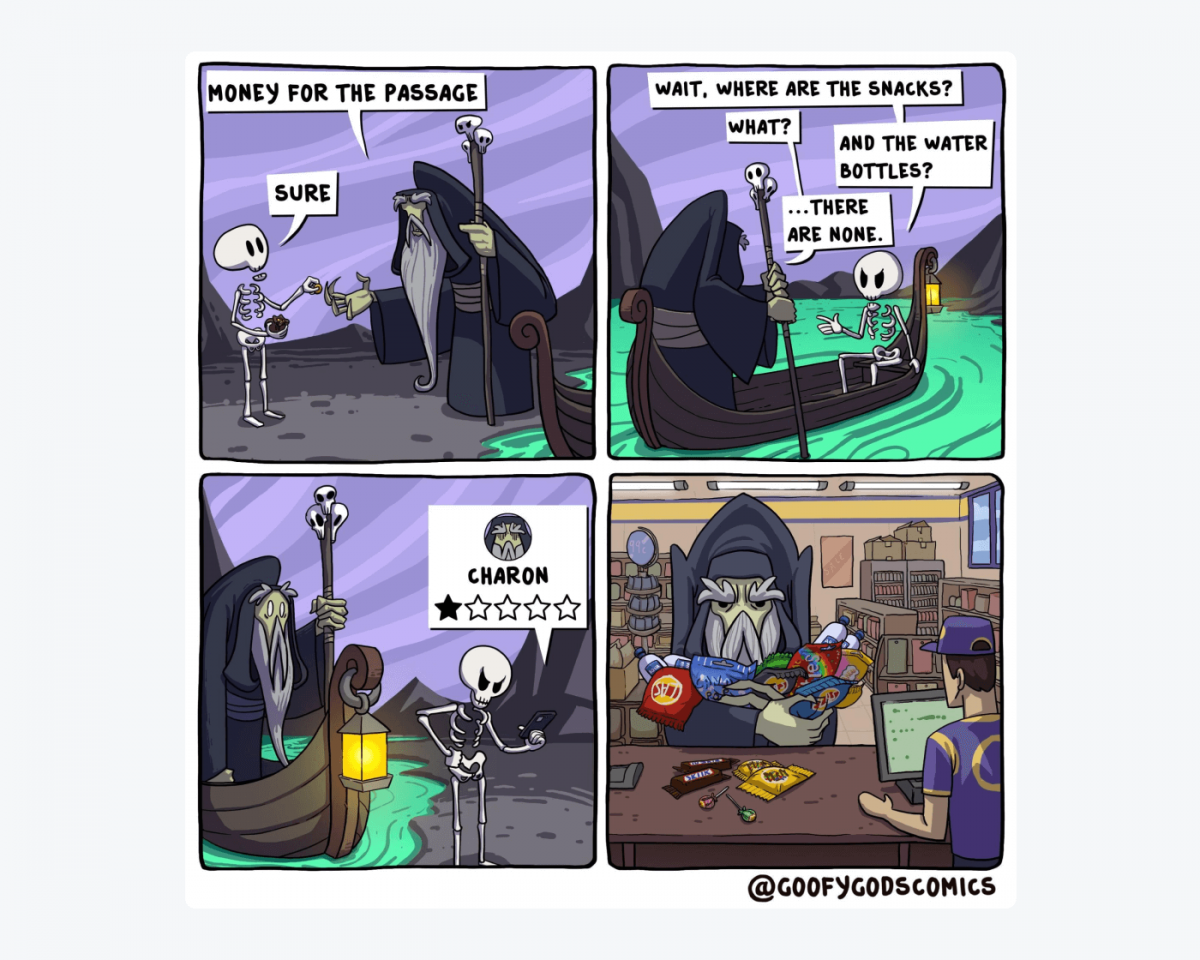
But what does that mean in reality?
Each consumer prefers a specific time they want a brand to contact them. They also have a preference on how often the organization communicates with them. Some also prefer for the organization to interact with them via a phone, others via an email or social media.
A lot to think about but don’t worry. We got you covered—
When we look at the numbers, most consumers (83%) want to be contacted by email, and 39% prefer a business to contact them in the afternoon.
To find your buyer’s specific preferences, you can collect customer feedback. Also, you can ask shoppers how they would like you to contact them during their subscription process.
This brings us to the last reason why customer communication is important.
Customer communication differentiates you from competitors
To stand out from the competition, your company needs to build lasting relationships with customers. And you can do that through a dialog.
The expansion of the internet and social media increased the importance of customer communication. Customers expect to be able to communicate with businesses, and they expect prompt replies. That is how customers assess accountability and reliability. It's what differentiates a good business from a shady one.

A business relationship is an ongoing exchange with clients to fulfill their needs and desires. So, focus on understanding the behavior of your customer base and the role of communication in customer relationships.
Understanding this is crucial to establish customer service with effective communication and grow your business successfully. Let’s look at some business strategies to help you with that.
Effective customer communication: six strategies to implement
Start by defining who owns customer communication in your organization. Is it the sales department, customer service representatives, or customer success team? Decide who will be responsible for establishing and maintaining the interactions with clients.
Then implement these six essential strategies for effective customer communication.
1. Create an omnichannel communication
First things first—let’s look at what it is.
Omnichannel communication involves ensuring a seamless experience using different channels to connect with customers. So, no matter if the client contacts you through email, website, or social media, they’ll have the same great experience.
Creating this experience for your shoppers improves their overall satisfaction. Especially since 74% of consumers use multiple channels to complete a transaction with a company, and 76% expect a consistent interaction across them.
So make sure to provide multiple channels for your shoppers to contact you on their preferred platform, for example:
- Live chat
- Social media messaging
- Phone calls
- Face-to-face interactions (if you have a physical store)
Consider using a few of these channels and communicate with clients more effectively. If that seems like a lot of work to keep up with these communications, then look into chatbots for a helping hand.
Learn how to improve your customer communication using AI
2. Automate customer communication with chatbots
What’s the most frustrating thing about contacting the support team?
Waiting.
As many as 75% of retailers report losing customers due to waiting times. Why let that happen when you can get an unlimited amount of hands and improve the response times?
Bonus: chatbots never get tired, so consumers can get help at any time of the day or night.
Chatbots are effective in solving issues for 87% of customers. That’s a big chunk of traffic redirected from your representatives! In this way, they can focus on solving more complex problems that chatbots can’t help your clients with.
It seems like a win-win situation, doesn’t it? Because it is!
Learn how to create your own Tidio bot for free with this quick tutorial.
3. Improve onboarding and first-time communication with customers
About 88% of customers are more likely to stay loyal to your brand when your onboarding content is welcoming and educates them on the product.
So, stop the trend of customers returning your products and uninstalling your apps. Teach them how to use your products to their full potential.
How?
Add a little personal touch to your first interaction. Start with a personalized welcome message, then show the consumer how to set up your product. When they’re all set, have an interactive show of your features. Finish the onboarding process by providing a knowledge base that consumers can refer to and send check-up emails regularly.
Remember to keep your communications personal from the very beginning. Most importantly: get their name right.
A person's name is to him or her the sweetest and most important sound in any language.

Your customers will be frustrated if you get their name wrong in brand communication, or at least 76% of them will be.
Mistakes happen.
But if you know this is a potential frustration that could affect your brand image, prepare for it. Whenever your team engages in interactions with buyers, make sure they check if the name of the person matches the one they’re about to contact.
Sounds simple? Because it is! But it can work magic in saving you from embarrassment.
Learn how to provide good onboarding for your customers. Also, master customer onboarding emails with some examples.
4. Measure customer satisfaction regularly
There are a few tried and tested ways to measure your customer service quality. You can use Net Promoter Score, Customer Satisfaction Score, and Customer Effort Score to list just a few.
But first—start collecting customer feedback.
After every interaction with your shopper, ask them for quick feedback. Make it brief and easy to fill in. This way, you’ll be on top of what areas need improvements and how your clients feel about your brand.
And once you start collecting feedback you’ll be able to measure:
Net Promoter Score (NPS)
Net Promoter Score represents how likely your consumers are to recommend you. To measure the score:
- Prepare a survey asking your shoppers from 1-10 how likely they are to recommend your brand to their friends and family.
- Then subtract the detractors (score 1-6) from promoters (score 9-10).
It is important to keep track of this metric to understand how happy your customers are with your business and how likely they are to recommend you. To find out more about the NPS check out this article.
Customer Satisfaction Score (CSAT)
This score determines how satisfied your consumers are with your brand. To measure your customer’s satisfaction:
- First, create a customer satisfaction survey
- When you have the responses, divide the number of satisfied shoppers by the total number of survey responses
- Then, multiply the result by 100
Customer Satisfaction Score (CSAT) is important to measure to find the percentage of your clients who are satisfied with your business. This way you’ll know where you’re standing and can ask additional questions to find out what’s wrong if your score isn’t as high as you want.
Last but not least—
Customer Effort Score
Customer Effort Score shows how much effort your customer needs to go through to solve their problem. You can calculate it this way:
- Collect survey responses on a 1 (strongly disagree) to 7 (strongly agree) scale
- Then divide the sum of responses by the number of responses given
When you measure the Customer Effort Score, you’ll know if your processes need improvements to make them easier for your clients. This could include tweaks to your customer service procedures, enhancements in the shopping journey, and other areas of customer experience.
Bottom line:
Ask for feedback after customer service interactions and send out surveys for your shoppers. This way, you can stay on track with how happy your clients are with your business and how likely they are to recommend you.
Check this list of 10 commandments of effective communication for additional understanding of the rules of good interactions.
5. Educate customers
Provide your customers with a knowledge base and a blog where you can share insights from your industry. Educating your clients will help you establish authority in your field and help your SEO efforts.
When you have the extensive industry knowledge and provide free resources, shoppers will be more likely to buy from you. You’re becoming the authority, and they know they can trust your services. And if they’re not ready to purchase right away, then you’ll be the first one on their minds when the time comes. That’s what this is all about.
Create an online forum where customers can exchange information and tips amongst themselves. It empowers them to help each other. Forums are useful for when your clients get stuck on a technical issue and help you create a brand’s community.
Ensure consumers have access to appropriate information about the product. This is vital for them to make informed decisions on their own.
A study shows that investing in customer knowledge strengthens trust in a brand and acts as an important differentiating factor. So, become transparent and educate the consumer to gain their trust and advantage over your competitors. They’ll be grateful and value your services even more.
Discover more about the power of educating consumers in this article.
Educate your customers and let them educate you:
6. Switch to proactive communication
Proactive customer service is all about reaching out to clients and directly engaging them with your business. It adds value to a customer’s experience by predicting future problems, helping customers instantly, and getting well-timed feedback.
So, if you only interact with clients when they contact you, then it’s time to change it.
Why?
Because about 68% of customers have a more favorable view of companies that offer proactive customer service. So, even if you fail at something, they are more likely to forgive and forget.
Providing proactive communication includes reaching out to customers, asking for feedback, and keeping your clients informed about any changes or updates. Make sure your customers feel involved and are part of your business improvement process.
But ensure you use the right tools and frequencies.
Find the ideal channel and frequency of communication for your shoppers. As mentioned earlier, each customer group has different preferences. Make sure you know what your clients like best.
Collect surveys and feedback from your consumers to find the most effective way to interact with them. Follow what they recommend to you, and you’ll be one step closer to effective communication with customers. Use contact management software to pinpoint the perfect communication strategy for each customer. Those tools help you stay in tune with what your clients want by tracking their preferences and engagement history. It’s like having a map that guides you to the sweet spot—where your messages are timely, relevant, and appreciated. Keep refining your approach based on real data, and you’ll dodge the communication pitfalls that frustrate so many shoppers. Stay sharp, and your customers will notice the difference.
But remember: Only communicate with your customers when they subscribe and stay on track of your interactions with clients. A whopping 94% of shoppers are annoyed by the communication from businesses. Don’t let that happen to you.
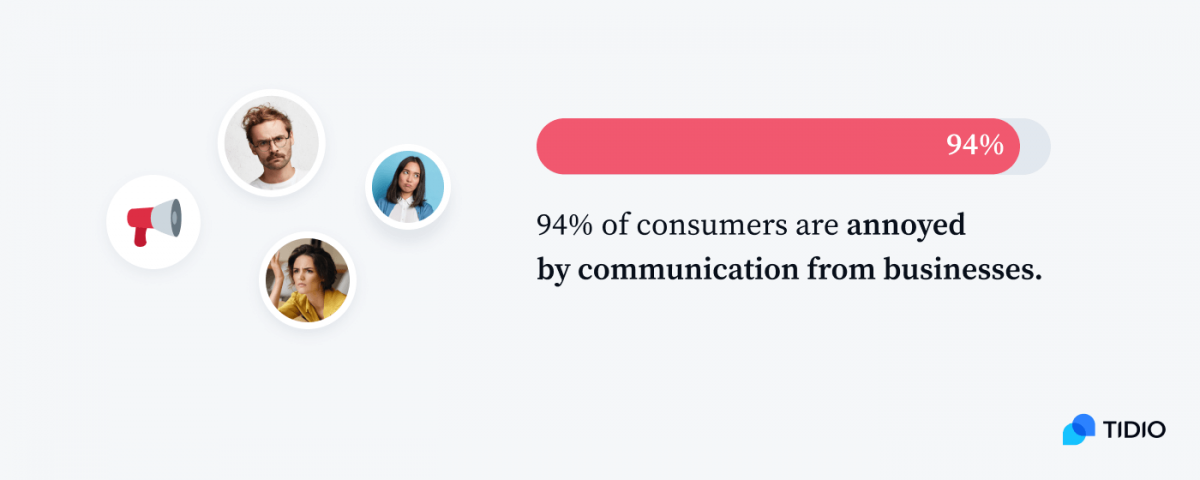
You can check out some customer relationship management systems in this article.
What to avoid in customer communication?
At this point, you get the picture of what to do. But it’s just as important to know what not to do.
Here’s a quick cheat sheet with things to avoid in your communication with customers:
1. Sounding generic
Personalization of your interactions should become a priority for your business.
Everyone wants to feel special and be treated as an individual. As we mentioned above, make sure your representatives get the name right, give some recommendations, and customize their interactions with every client.
Small improvements can sometimes make huge differences. And small tweaks to personalize your communication with consumers are one of these.
2. Empty promises
Gallup’s survey states that the highest-performing companies deliver on their promises about 25% more often than their lower-performing competitors.
Save your clients from disappointment and yourself from losing credibility. Make sure your support and sales teams are confident that your company can provide everything they tell consumers.
3. Long waiting times
A study shows that nearly 60% of consumers are not willing to wait on hold for longer than a minute.
And the average time a customer will stay on hold before hanging up is 90 seconds.
What’s the result?
If you keep people on hold, they’ll purchase less, the number of irritated shoppers will increase, and your brand image will turn South. That’s a high cost for one failed area of customer service.
To not let that happen to your brand, implement chatbots and an option to phone the caller back. This will decrease the queue and improve your clients’ satisfaction.
4. Unhelpful customer service reps
That’s where the training of your employees comes in.
Make sure they can answer any and all of the questions your clients have about your products and services. Especially, since this Microsoft survey shows that unknowledgeable reps are one of the top customer frustrations.
Think about it.
How many times did you lose your nerves because the rep you spoke with didn’t know the answers to your questions?
5. Too frequent or seldom interactions with potential customers
Don’t do it too often. But also don’t neglect it. You need to find a sweet spot for your communication with consumers. And make sure you stick to it with your promotional emails and other interactions.
Most important: never contact a consumer if they didn’t give you specific permission to do so. You’ll only harm your brand, rather than help it.
Check out the best times to send emails to customers.
Customer service communication skills required for the job
Communication is the number one customer service skill that your representatives should display. But what comprises that skill?
The three most important customer communication skills are:
1. Active listening
Active listening skills include listening and fully understanding your customers. Make sure your employees do their best to fully understand the client and support them.
Active listening includes focusing on hearing what the customer is saying and interpreting the meaning of their words. Then, responding in a positive manner, demonstrating you understand the issue and consider it important.
A few useful practices for active listening are:
- Learn to tune out all distractions and fully focus on what the client is saying
- Do not interrupt
- Look at the body language, listen to the tone, and other implications for getting the full picture of the client’s frustrations
Learn how to improve your active listening skills with this video:
2. Empathy
Make sure your representatives are empathetic and can relate to your client’s feelings and situations.
That means they can put themselves “in someone else’s shoes” and understand the other person’s situation and feelings from the person’s point of view. They should also be able to communicate that understanding back to the other person.
This is one of those skills that are difficult to learn, so ensure the people you’re employing are empathetic by nature. This way, they’ll be helping your customers because they want to and not because they have to.
Check out the six habits of highly empathetic people and try to implement some of them into your life to improve your empathy skills.
3. Use of positive language
Instead of focusing on the negatives, make sure your employees use positive language when interacting with shoppers.
Stop apologizing for long waiting times and what you can’t do, and focus on the optimism around what you can do for the client and what their best options are. Use more of “I’m excited to tell you that we can … for you” and be optimistic about what you’re telling them.
You might even be able to win them over.
Being formal is always a safe bet when it comes to effective communication in customer service. But there’s a catch—you might end up sounding robotic.
To avoid that, try implementing words such as: ‘absolutely’ or ‘sounds good’ to show a more personal and positive side of your business.
Find out more about the use of positive language in customer service communication from this article.
Check out our other article to learn more about specific customer service skills.
Customer communication management tools
Finally, here’s a list of handy software to help you manage your customer communications effectively.
1. Tidio
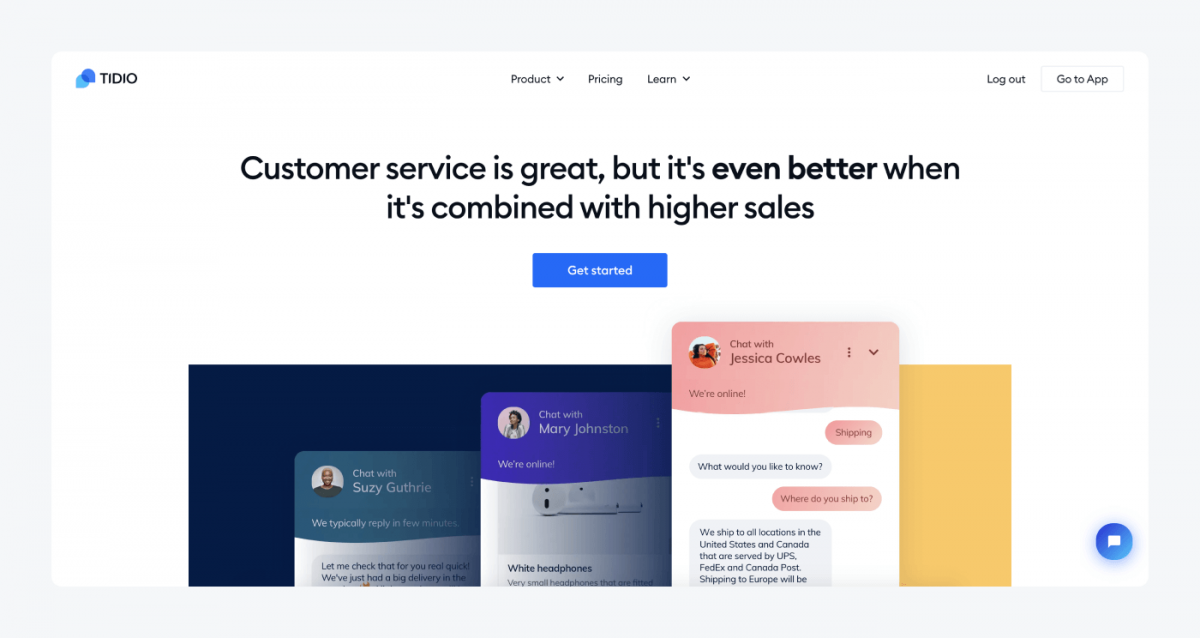
Tidio helps your business communicate with consumers quickly and effectively by providing you with a live chat feature and chatbots.
- You can connect with your clients and provide support through the live chat feature or let chatbots handle some of their questions. This gives your clients an additional means of communication with your brand.
- In addition, you can see previous messages and inquiries the shopper had. This helps you learn from your interactions and improve relationships with consumers.
- Remember when we talked about the importance of personalization? Tidio helps you personalize the experience for each customer. You can see the customer journey on your website in real-time and what they’re typing before sending the message. In this way, your representatives know what the customer is interested in and where they encountered troubles.
Tidio is designed for small and medium businesses that want to improve customer service communication and consumer relationships.
Pricing: Free tool available
Read more: Check out the top customer communication management tools available.
2. Podium
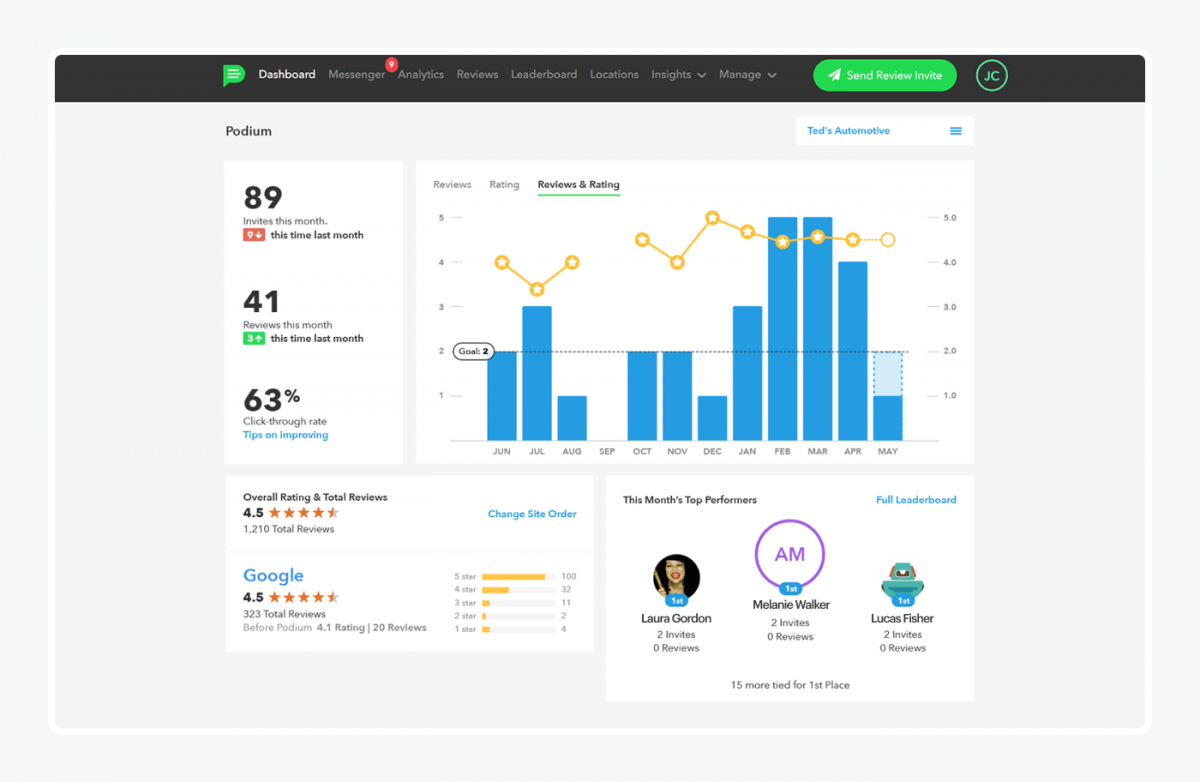
Podium is a messenger platform that improves customer engagement with the company through text messages.
- Utilizes text messages to build an online reputation and better manage customer relationships.
- It helps to gain and keep track of online reviews allowing users to view them and send review invitations from their dashboard.
- Consumers can connect with the business through Facebook, Google, or text message.
Podium is best suited for local businesses who need help collecting reviews and handling all interactions from one inbox.
Pricing: Paid—Custom quote
3. Pipedrive
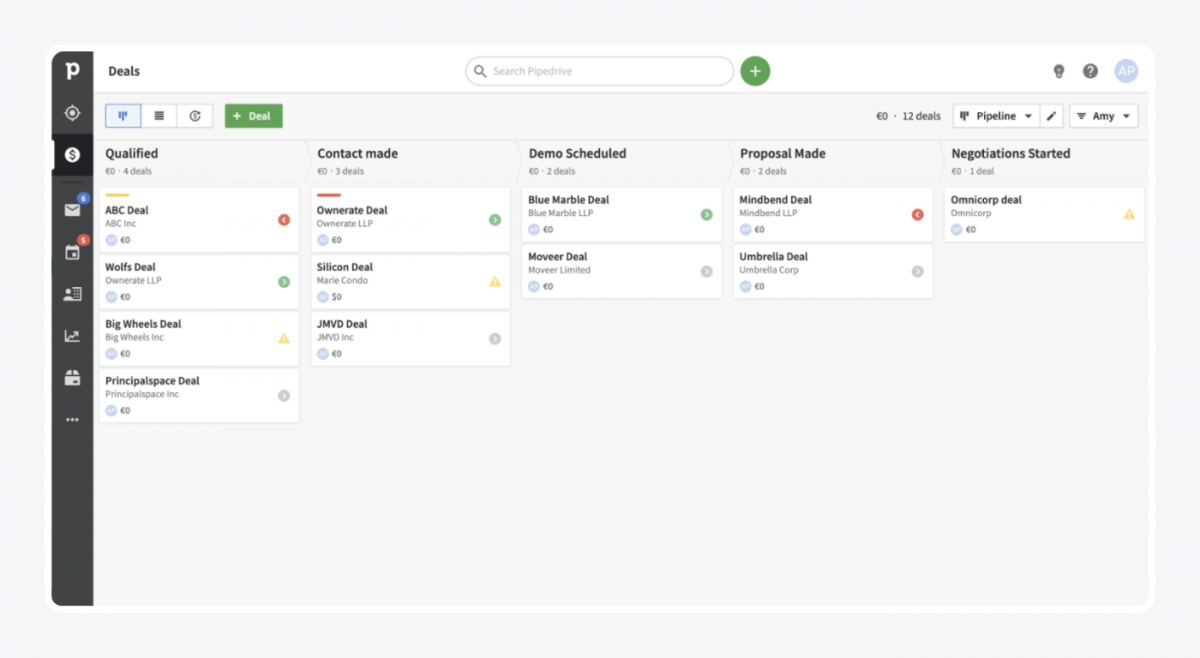
This web-based sales customer relationship management (CRM) system helps you with your sales, closing deals, and client communication.
- The platform provides automation in tracking calls, emails, and other communication to give you a complete view of the consumer’s sales journey.
- It automates sending routine follow-up emails and other repetitive tasks to free up your team members’ time.
- You get insights into your business, and you can measure performance easier.
Pipedrive is for those who want to have their sales journey organized in one place.
Pricing: Paid—between $12.50 and $99
4. Front
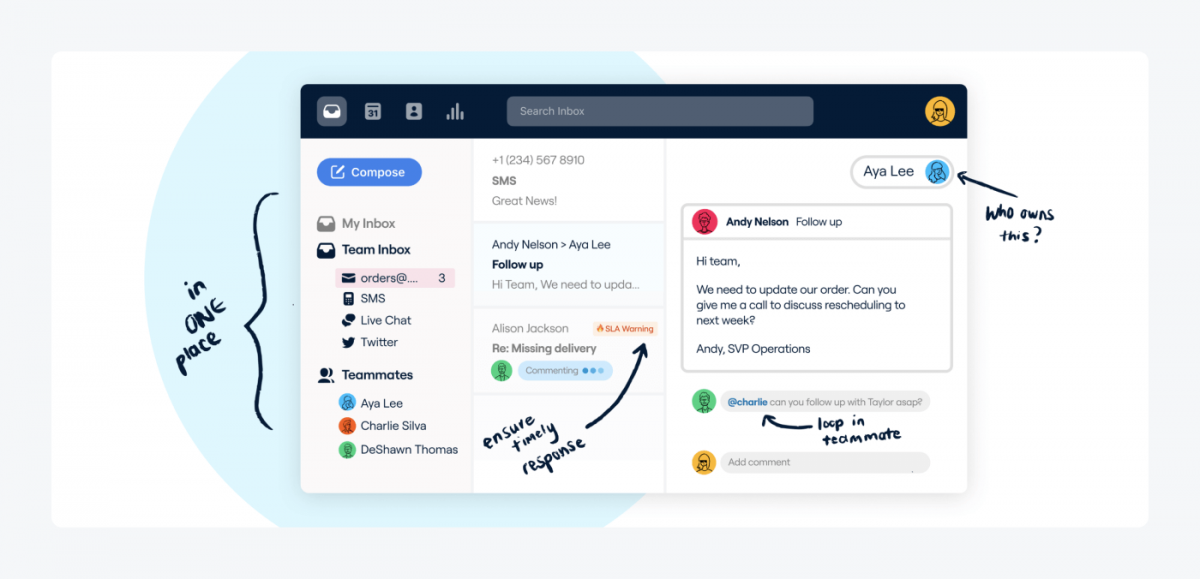
This customer communication hub combines email with a CRM system to make your interactions more efficient.
- You have all your channels, such as emails, texts, Twitter messages, and live chat, in one view.
- Your team can share drafts and have backstage conversations with each other regarding their messages to consumers.
- You can assign messages to the right people to stay organized and ensure two reps are not working on the same contact.
Get Front if you need a platform to organize your company’s interactions with clients from various channels.
Pricing: Paid—plans start from $19
5. Freshdesk
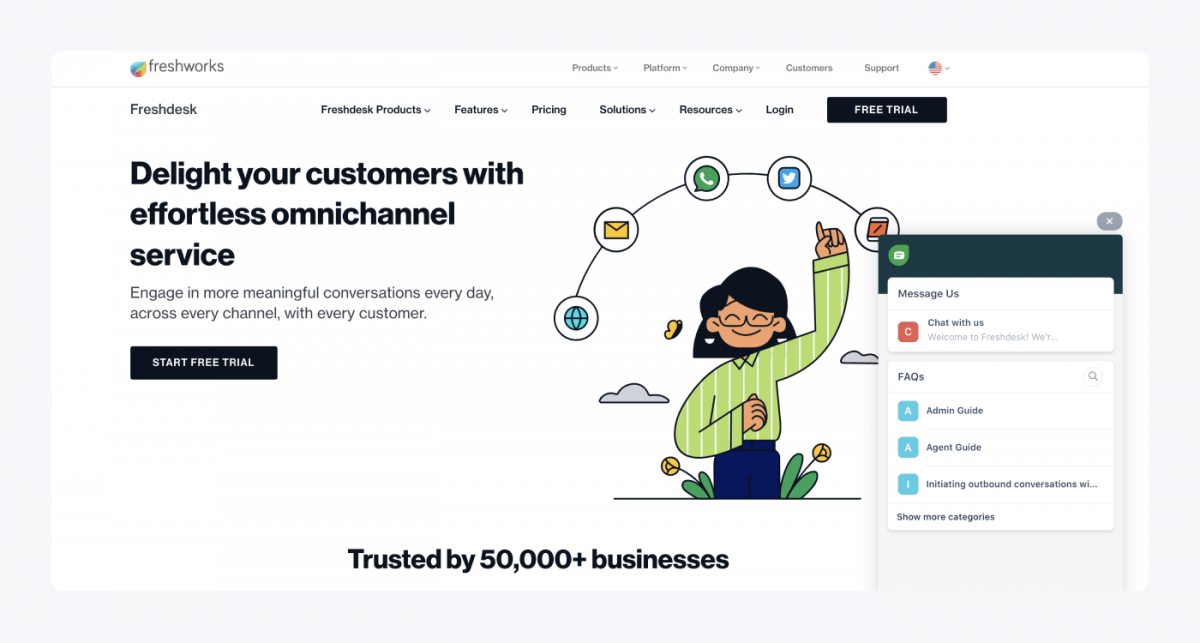
This cloud-based software helps with omnichannel communication by providing one platform to organize and manage client relations.
- You can monitor all your conversations with customers from different channels.
- You can use chatbots to automate users’ self-service experience and solve most of their inquiries.
- The software monitors your metrics with embedded analytics.
Freshdesk is designed for businesses that need help organizing their customer communications and providing them more effectively.
Pricing: Free tool available
If you’re interested in more customer communication digital tools, check out these articles:
- 17 Best Live Chat Apps in 2022
- 10 Best Chat Widgets in 2022
- Best Web Chat Tools and Services
- Top Freshdesk alternatives
Customer communication trends to watch out for
This shouldn’t come as a surprise—customers are moving online. So, to grow your business, you need to adapt your methods and communications to the new realities.
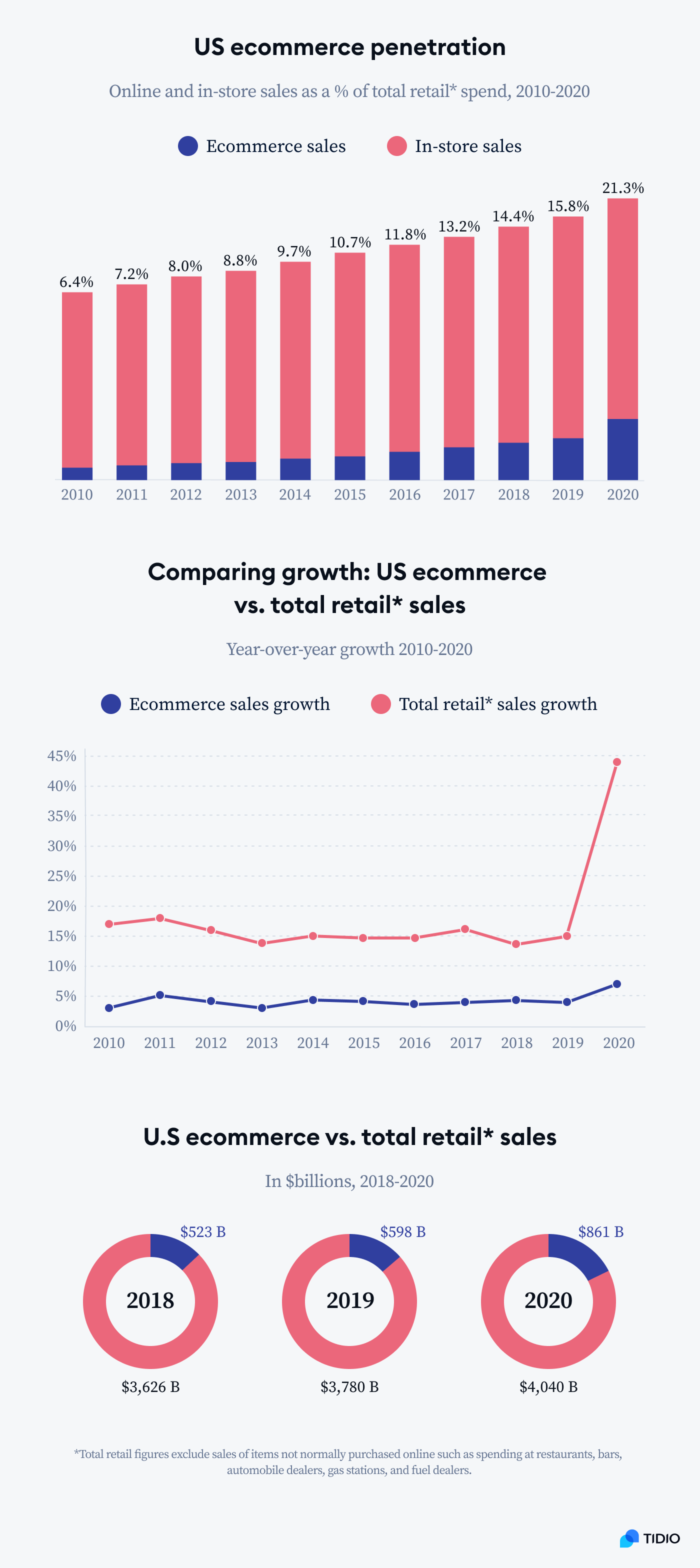
Digital Commerce found that U.S. ecommerce increased by 44% in 2020 alone. That’s the highest annual growth for U.S. ecommerce in over two decades.
A study by Aberdeen Group Inc. found that companies offering omnichannel customer experience management (CEM) have, on average, a 91% higher retention rate increase than organizations that don’t have an omnichannel program.
They also have a 3.4% increase in lifetime value compared to those without omnichannel experience, whose customer lifetime value decreases by about 0.7% each year.
Gartner states AI is the future of customer service. It predicts that by 2022, 70% of customer interactions will involve machine learning, chatbots, and mobile messaging.
To best prepare for the future, take two simple steps.
First, jump on the bandwagon and boost your online presence. Build a website where people can purchase your products and services. Also, make sure you join social platforms where your clientele is. Since shoppers contact businesses through different channels, be where they are to ease this process for them.
Secondly, implement live chat and chatbots into your online platforms. AI technology is already helping businesses with their consumer relations. Learn how to create your own chatbot and let it handle some of your clients’ issues.
Get these right, and you’re two steps closer to being prepared for what the future holds.
Key takeaway
Customer communication is the foundation of your company. Once that crumbles, your entire relationship with the consumers will follow.
To avoid that, follow these simple strategies for effective communication:
- Create an omnichannel experience
- Implement chatbots into your channels
- Improve customer onboarding process
- Measure customer satisfaction regularly
- Educate consumers on your product and area of expertise
- Make your communication proactive
Also, implement some of the tools we mentioned above and look out for the best customer communication skills to ensure your employees have them all.

